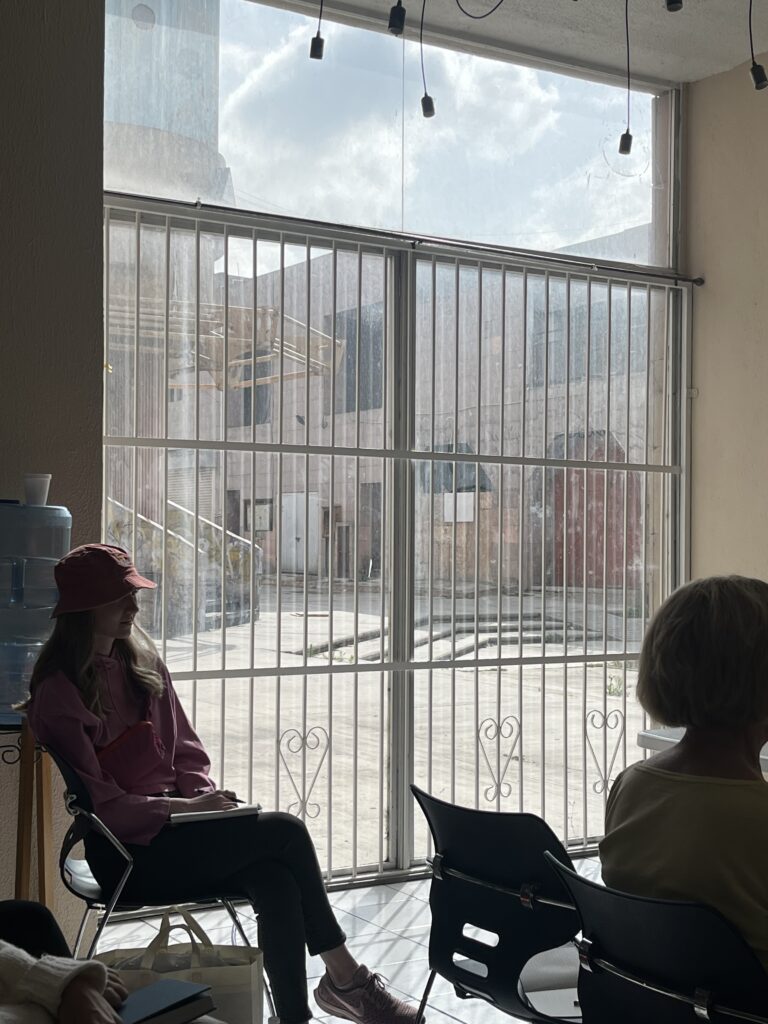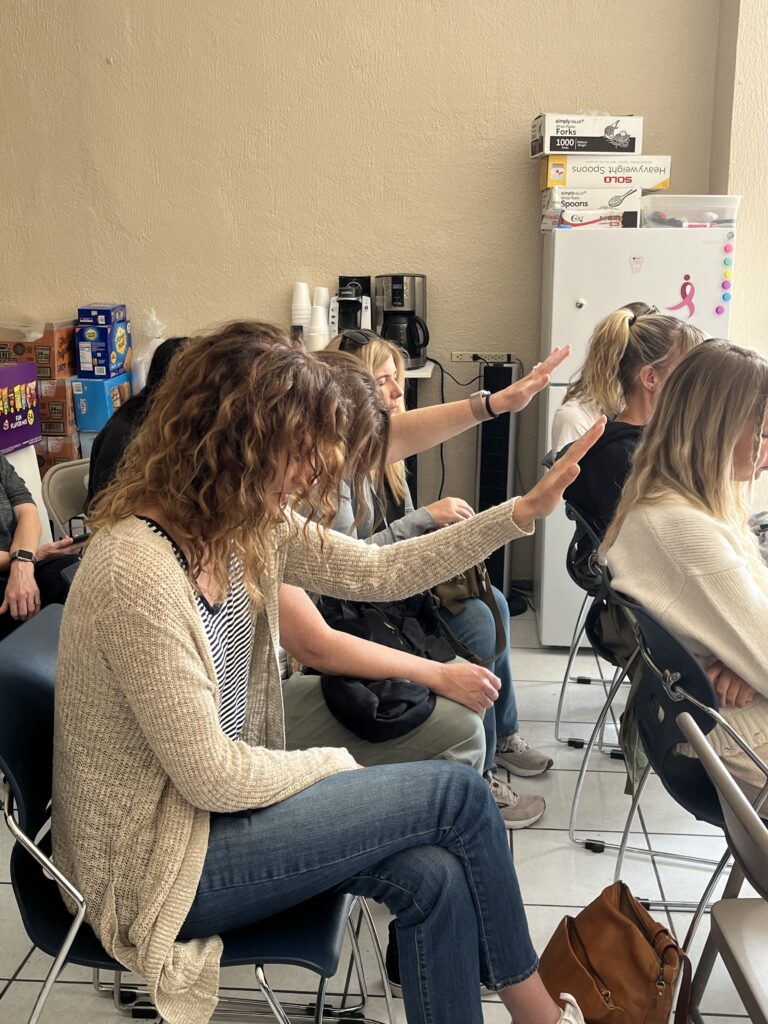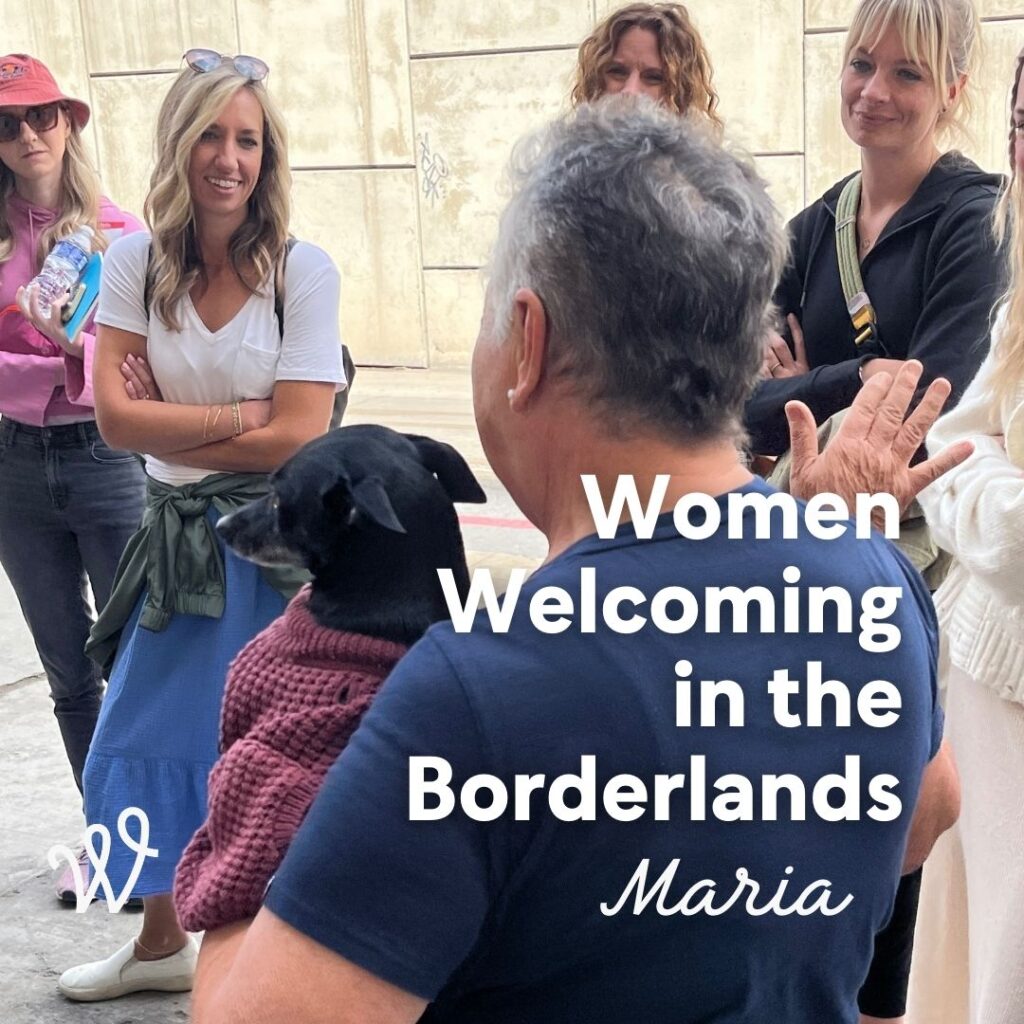We are sharing the stories of two women we encountered recently on border immersion trip. These women are doing amazing work welcoming vulnerable people in the borderlands. We hope their stories will challenge and inspire you to learn more and pray about how you can share Christlike welcome in your own communities.
Maria
I look around at the scene and realize I am standing on holy ground. The light filters in from the courtyard illuminating hands outstretched in prayer. The women in the room all just met the day before, flying in from all over the country to be part of a Women of Welcome border immersion trip together. We also just met the woman at the front of the room we are now praying together for. She speaks about the sacrifices she makes to run the migrant center just south of the U.S. border like they aren’t miraculous. They are.
Maria is seventy-five years old and walks across the busiest border crossing in the world five days a week to give her time and energy to people from all over the world looking for safety and security. She runs the center by herself with volunteers who come and go for teaching through the week. Some teach English classes or sewing to migrants waiting to have their asylum cases heard in the U.S. Thirty to fifty people come every day looking for food and clothing, finding what provisions they can while they wait.
The immigration rules are changing all the time
Maria does what she can and points them to a shelter where they can stay for the night. Many have been waiting for over a year for their turn to apply for a chance to prove they are fleeing persecution in their home countries so they can enter the U.S. as an asylee. Most have not been able to have their asylum claims heard because of Title 42, a rule in place during the pandemic that turned migrants back around into Mexico. Many have come a long way for this chance: from Venezuela, Cuba, and Haiti. Others have recently come from as far as Afghanistan, Ukraine, and Egypt. Most don’t understand the rules as to who can enter and who can’t. The immigration rules are changing all the time. Most are deported into Mexico where they do not know the language. There aren’t enough shelters so many people end up sleeping on the streets.
These people have no one else to help them
 “You must be patient,” she tells the migrants who visit the center. She tells us people encourage them to try to cross between ports of entry, preying on the vulnerable families for money. She counsels them to wait for their turn, to keep coming to the center. “Imagine,” she tells us, “that today you couldn’t walk back across the border into the U.S. What if you got stuck here? Would you know anyone to help you—to give you food or a place to stay? These people have no one else to help them.”
“You must be patient,” she tells the migrants who visit the center. She tells us people encourage them to try to cross between ports of entry, preying on the vulnerable families for money. She counsels them to wait for their turn, to keep coming to the center. “Imagine,” she tells us, “that today you couldn’t walk back across the border into the U.S. What if you got stuck here? Would you know anyone to help you—to give you food or a place to stay? These people have no one else to help them.”
We ask how we can pray for her and she tells us that World Relief has been helping cover the rent for the center, which has been a great relief. “It was harder before that,” she tells us. “But I still need to pay for electricity and water, buy food and clothing for the migrants. We don’t have internet installed here and need that.” Maria works on the weekends to make money to make up the difference for the costs of the shelter. “Pray for volunteers,” she asks. “I want to be able to be open daily. I have to close on the weekends so I can work.”
After we pray, we are told we must get on the bus quickly to get to our next stop further into the interior of Mexico. We linger as long as we can, a few ladies grabbing purses and aprons to remind us of Maria and the work she is doing. The migrant women who visit the shelter crochet bags and hats to pass the time and Maria sells them to cover some of the expenses. We press cash into her hands and wish we could do more. We tell her we will not forget.
Now, what will you do?
 We step back onto the street and see people waiting under an overpass. Men stand around, waiting for nothing in particular, it seems. One of our leaders points out they do not have shoe laces in their shoes—a sign they were held in detention and deported. Maria told us 200 were deported the day before. Most came from Venezuela and have been waiting three months for their chance to make their asylum claims. She told us that many from Venezuela have valid asylum claims but need to have a sponsor in the U.S. to receive them. “If you are fleeing persecution, running from danger in your country, are you going to have a contact in the U.S?” she asks.
We step back onto the street and see people waiting under an overpass. Men stand around, waiting for nothing in particular, it seems. One of our leaders points out they do not have shoe laces in their shoes—a sign they were held in detention and deported. Maria told us 200 were deported the day before. Most came from Venezuela and have been waiting three months for their chance to make their asylum claims. She told us that many from Venezuela have valid asylum claims but need to have a sponsor in the U.S. to receive them. “If you are fleeing persecution, running from danger in your country, are you going to have a contact in the U.S?” she asks.
We take a final photo with Maria and get into the van. We sit quietly for where are the words? We watch the double border wall glide by the window and continue to think of Maria and the women and children she serves every day. We whisper prayers and ask God for mercy, for provision. We ask for the ability to share her story and for hearts of compassion to receive it. Now that you’ve heard it, what will you do?

 This resource answers the most common questions Christians have about immigration and equips you to engage conversations with biblical clarity, truth, and grace.
This resource answers the most common questions Christians have about immigration and equips you to engage conversations with biblical clarity, truth, and grace.